click on images to enlarge
A CANTEEN OF SILVER
This article is about a boxed set of silver plated flatware, shown in a picture at the end of
the article, and the problems for an American trying to read its marks.
The owner thought this type of boxed set was properly called a canteen.
Not so. A canteen is simply a set of tableware often with 12 place settings.
A half-canteen has 6 place settings and a double canteen has 24. There
are other sizes and often any boxed set of silver tableware may be
properly labeled as a canteen.
Canteen in English translates simply to a Ďsetí in American. The set may be in a box.
A dessert boxed canteen with 6 forks and 6
spoons made in Sheffield by James Dixon & Sons in 1905, in the reign
of Edward VII.
A canteen does not have to be accompanied by or contained in a
fitted box.
(see note 1)
|
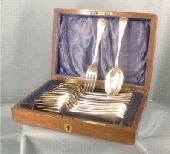 |
Much of the information on this page came from a web site that is
very informative (see note 2).
The box containing the silver may have its own makerís mark.
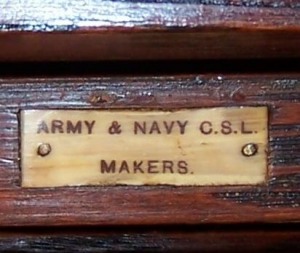 |
Starting with the box: Makers mark on authorís canteen box. The Army and Navy
Co-operative Society Ltd was formed in 1871
by a group of army and navy officers. It was their intention
to supply 'articles of domestic consumption and general use to
its members at the lowest numerative rates'. The first store
opened on 15 February 1872 at Victoria Street, London. At the end of
1873 a gun department was established. The contents of the box were probably made after 1872.
And also before 1934.
|
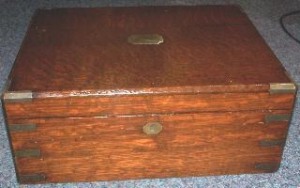 |
By the end of the century the Society was issuing an enormous
annual illustrated price list, had introduced telephone ordering and
had reduced mail order prices. In 1934 the company's official name
became the Army and Navy Store Ltd and in 1973 Army and Navy Stores
was taken over by House of Fraser.
(Taken from Michael Moss and Alison Turton, A Legend of Retailing,
House of Fraser: London; Weidenfield and Nicolson, 1989.)
|
It is possible this box and contents were assembled by the Army &
Navy C.S.L. as the pieces inside are of 1900 to 1910 manufacture by
William Hutton & Sons in Sheffield, England.
The knives, all but one, were made for the Army and Navy C.S.L.
It was a practice of English officers to travel with a canteen of silver
to entertain in a proper fashion and style when posted to distant parts
of the English Empire.
The oak box would have made a good companion piece to the wooden
campaign chests, desks, and beds with which they also traveled.
Other terms used to describe a canteen are:
straight, meaning all the spoons and forks are of the same
dates, and mixed, meaning there will be some variation of the above.
This canteen is straight with the exclusion of one knife.
All the silver has one maker, William Hutton and Sons, all are close to
the same date 1900-1910, and are of the same pattern, simple English.
The knives in such an officierís set can vary even more. The blades may be of steel, stainless
steel, or silver (rare). The handles may be of silver, ivory, bone, or a
plastic made to look very much like bone. One knife out of 24 in this
set is not by the same maker.
In this canteen the blades are steel, the handles are not silver, and
considering the date of 1900-1910 would be of ivory or bone. Perhaps a
reader can tell us.
The terms Sterling and solid silver mean at least 92.5% of the
article was silver. The assay mark was distinct for each English town
which had an assay office and each piece of solid silver ware to be sold
was assayed and punched if acceptable or destroyed if not acceptable.
During the late 1700s these were primarily London, Birmingham,
Sheffield, and and Chester. This set is not sterling.
The Sheffield Plate process involving heat fusion of two metals was
discovered by Thomas Boulsover in 1743 and made a commercial success
about 1748-1750 by Josiah Hancock. This process allowed the ownership of
silver household wares to move from the very rich (Sterling) to the
entire upper classes.
Fine Silversmith firms soon made both types of wares. The solid silver
had an assay mark indicating the amount of silver in the article.
The Sheffield Plate did not. It also did not have a duty mark as the
firm did not pay a tax to the crown for each piece produced. Some cities
such as Glasgow, Scotland, and York, England did use town of origin and
date marks. Sheffield Plate did not have date marks. This set is not of Sheffield Plate.
The Electroplating technique was discovered piecemeal and in 1840 the
firm of Elkington & Co. of Birmingham acquired all the available
patents. Shortly thereafter William Hutton obtained from Elkington and
Co. the right to use this technique and while already producing Sterling and Sheffield
Plate, now added Electroplate wares.
Electroplating soon thereafter became a serious competitor of the fused
Sheffield Plate and made the ownership of fine silver household pieces
available to the middle classes.
Sheffield Plate and Electroplate were only silver on the outside but
made the same fine appearance on the table or sideboard.
Sheffield Plate held a firm place in the market until 1840 (nearly 100
years) before production all but ceased in favor of the less expensive
and often more durable Electroplated wares.
The Sheffield electroplating process, as available from firms paying the
required royalty to the Elkington firm, held sway from 1838-1840 to a
little after 1900. Other electroplating techniques then supplanted the
original. How was this set dated to 1900 or shortly thereafter?
Queen Victoria's reign (1837 - 1901) has
given the name Victorian Plate to silver plate made in England by
the original electroplating method during these years.
|
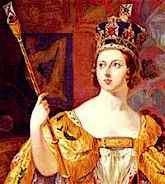 |
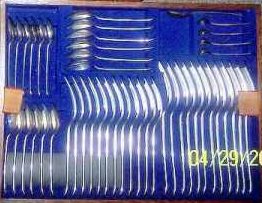 |
In this set the silver markings are identical on all the
forks and spoons. These are not sterling, and though made in
Sheffield, are not Sheffield Plate. They are electroplated silver
from Sheffield, England, made between 1900 - 1910 by the firm of
William Hutton and Sons.
|
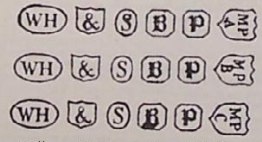 |
These are marks used on William Hutton & Sons British Plate Metal Plate
(?) A B or C quality(?) It is assumed that MP stands for metal plate.
|
As assay, date and duty marks were not used on the Electroplated
Sheffield wares, the Makers mark is the main source of hints as to a
date more precise than 'Victorian'.
This canteen containing Victorian Plate by William Hutton and Sons is
dated rather precisely to 1900 to 1910 by the makerís mark.
William Hutton made fine solid silver pieces, fine Sheffield plate
pieces, and fine electroplated pieces.
The Creswick firm did the same. William Hutton and Sonsí marks varied
depending upon whether the article was Sterling, Sheffield Plate or
Victorian Plate.
Above are examples of some of his marks used on Victorian Plate (see
note 3).
In 1900 William Hutton bought out the Creswick firm and for no more than
10 years he continued the use of their mark preceding his own firm's
mark (see note 4).
These are the marks used on the canteen under discussion. What to make of the Creswick and Co. arrows?
The mark reads:
8 crossed arrows (4x4) registered to the Creswick firm and
transferred to William Hutton when he purchased that firm,
WH & S for William Hutton and Sons,
B P in old English Script [perhaps resembling date and town
marks] but meaning British Plate.
MP over A1. The MP is not identified yet. A good guess is Metal
Plate. The A1 is a quality mark with the same meaning it has today. In
the makerís opinion this was the highest quality his firm made.
After approximately 100 years there is no apparent wear to the silver plate and no area has
exposed nickel alloy base metal.
Endnotes
(1) http://www.payneandson.co.uk/as_stock/50-1535.html
(2) http://www.antiquesilverspoons.co.uk/canteens.htm
(3) The book of Sheffield plate - Wyler 1949 - Crown Publishers USA
(4) information supplied by Gary Bottomly
Jayne W. Dye - 2005
|